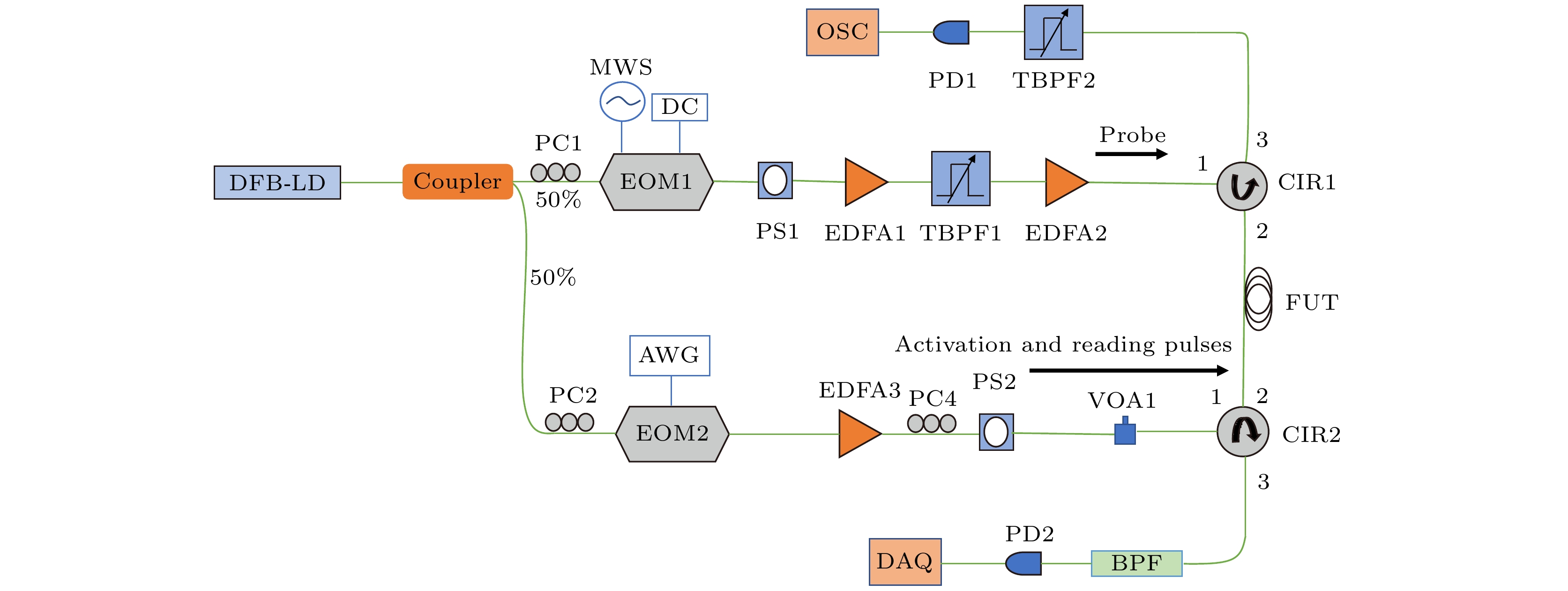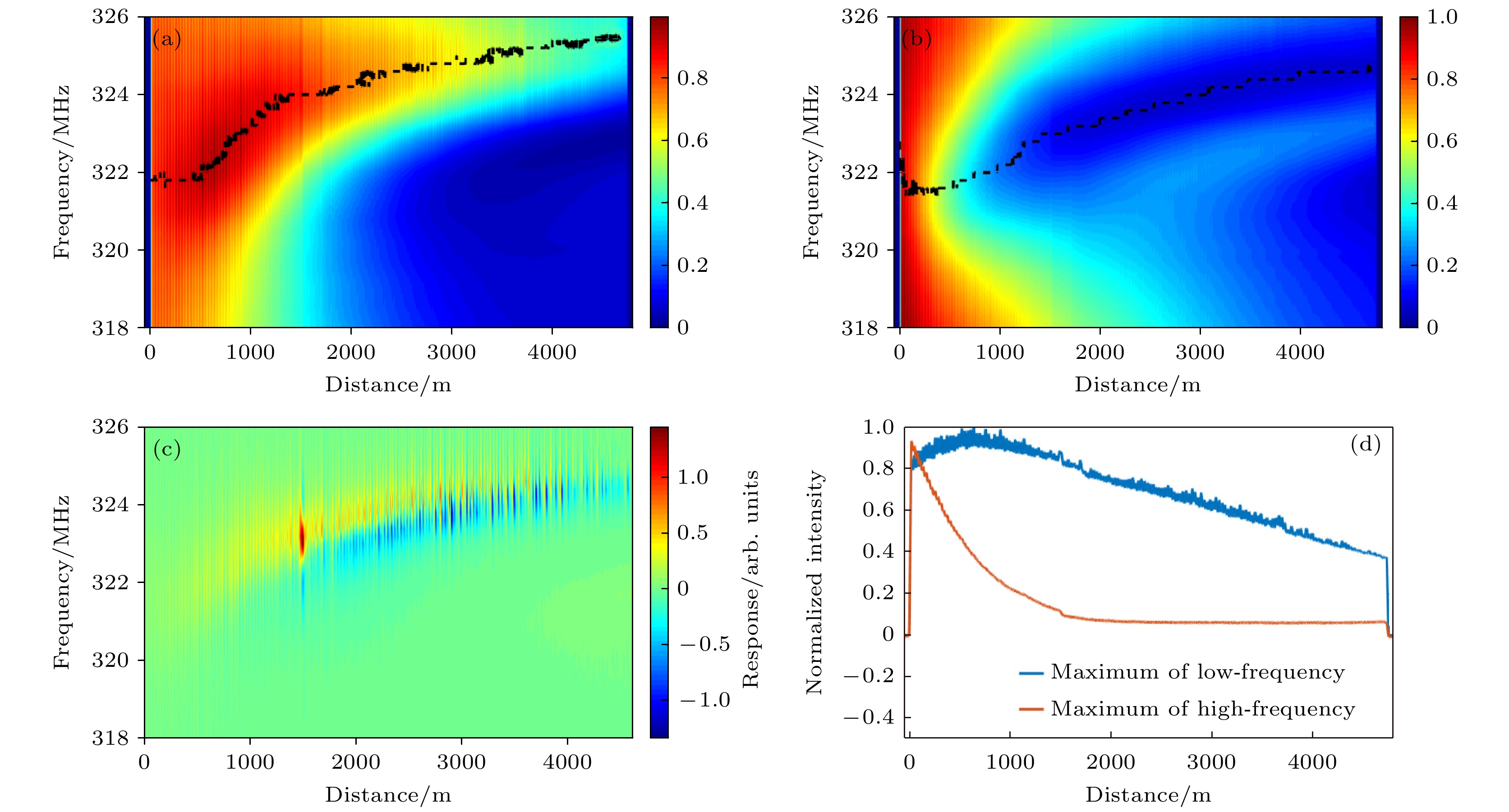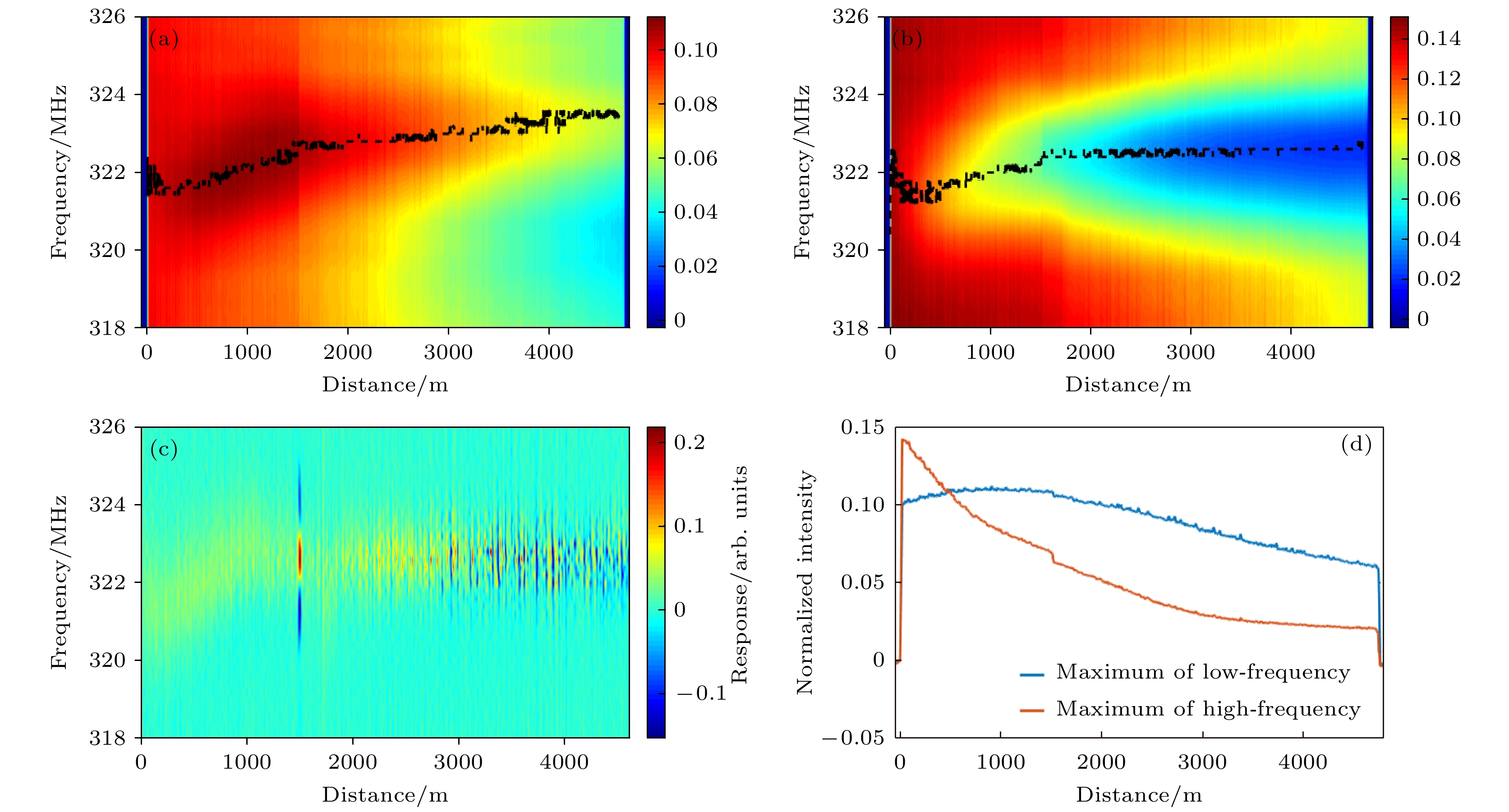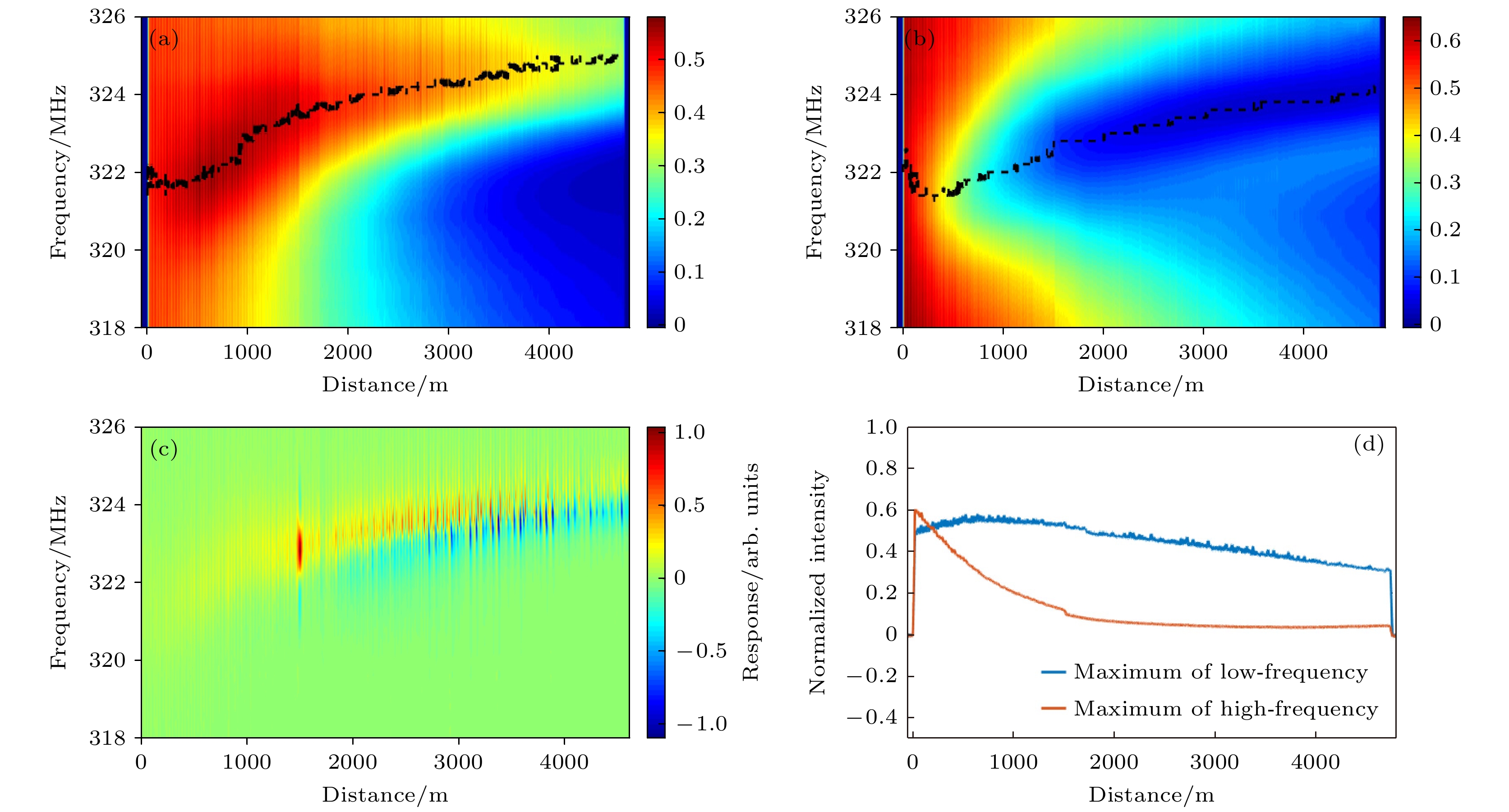-
以光力时域分析传感器为例, 实验研究了非线性效应对前向受激布里渊散射分布式传感的影响, 并给出了优化过程. 前向受激布里渊散射的产生由于增益系数低, 需要较高的脉冲功率(W级)进行激发, 由于读取脉冲光与散射光同向传输特性, 高功率脉冲将诱发前向受激布里渊散射传感系统中各种非线性效应. 借鉴前人激活-读取分离技术, 可有效避免激活脉冲非线性效应的影响, 然而读取脉冲非线性效应对传感性能仍存在直接影响. 基于此, 本文研究了不同读取脉冲功率条件下, 非线性效应对前向受激布里渊散射传感性能的影响及其物理机理; 具体展示了~4.7 km 标准单模光纤中, 一、二阶散射边带随读取脉冲功率的演化过程, 最终找到了优化区间, 得到较为完美的本地增益谱, 并且延长了传感距离.The influences of nonlinear effects on sensing performance of forward stimulated Brillouin scattering (FSBS) are investigated using opto-mechanical time-domain analysis sensor, which is taken for example. The excitation of FSBS often requires high pulse power (at Watt level) because of the lower gain coefficient. Owing to the co-propagation of reading pulse and scattered light, high-power activation pulses will induce various nonlinear effects in an FSBS sensing system. Using the reported method based on activation-reading time-domain separation, the influences of nonlinear effects due to activation pulses can be effectively avoided. However, the nonlinear effects of reading pulses directly affect the sensing performance. Based on this consideration, we study the influences of nonlinear effects on FSBS sensing and their physical mechanisms under different values of peak power of reading pulses; the variation process of the 1st- and 2nd-order FSBS spectrums along ~4.7 km standard single-mode fiber are revealed in detail. Finally, the optimal region is found, in which a perfect FSBS local spectrum is obtained, and the sensing distance can be extended.
-
Keywords:
- forward stimulated Brillouin scattering /
- nonlinear effects of fiber /
- distributed fiber sensing
[1] 王士鹤, 任立勇, 刘宇 2009 物理学报 58 3943
 Google Scholar
Google Scholar
Wang S H, Ren L Y, Liu Y 2009 Acta Phys. Sin. 58 3943
 Google Scholar
Google Scholar
[2] Zhang Y C, Chen W, Sun S L, Meng Z 2015 Chin. Phys. B 24 094209
 Google Scholar
Google Scholar
[3] Mu K L, Shang J M, Tang L H, Wang Z K, Yu S, Qiao Y J 2019 Chin. Phys. B 28 094216
 Google Scholar
Google Scholar
[4] Wang G, Xu L X, Gu C 2018 Chin. Phys. Lett. 35 084201
 Google Scholar
Google Scholar
[5] Shelby R M, Levenson M D, Bayer P W 1985 Phys. Rev. B 31 5244
 Google Scholar
Google Scholar
[6] Townsend P D, Poustie A J, Hardman P J, Blow K J 1996 Opt. Lett. 21 333
 Google Scholar
Google Scholar
[7] Biryukov A S, Sukharev M E, Dianov E M 2002 Quantum Electron. 32 765
 Google Scholar
Google Scholar
[8] Quang D L, Jaouën Y, Zimmerli M, Gallion P, Thomine J B 1996 IEEE Photonics Technol. Lett. 8 414
 Google Scholar
Google Scholar
[9] Shiraki K, Ohashi M 1992 IEEE Photonics Technol. Lett. 4 1177
 Google Scholar
Google Scholar
[10] Hua Z J, Ba D X, Zhou D W, Li Y J, Wang Y, Bao X Y, Dong Y K 2021 Light: Adv. Manuf. 2 373
[11] Ohashi M, Shibata N, Shiraki K 1992 Electron. Lett. 28 900
 Google Scholar
Google Scholar
[12] Tanaka Y, Ogusu K 1998 IEEE Photonics Technol. Lett. 10 1769
 Google Scholar
Google Scholar
[13] Carry E, Beugnot J C, Stiller B, Lee M W, Maillotte H, Sylvestre T 2011 Appl. Opt. 50 6543
 Google Scholar
Google Scholar
[14] Hayashi N, Suzuki K, Set S Y, Yamashita S 2017 Appl. Phys. Express 10 092501
 Google Scholar
Google Scholar
[15] Tanaka Y, Ogusu K 1999 IEEE Photonics Technol. Lett. 11 865
 Google Scholar
Google Scholar
[16] Lin J B, Jia X H, Xu S R, Ma H L, Wu H, Wei X Y 2019 Appl. Phys. Express 12 102014
 Google Scholar
Google Scholar
[17] Antman Y, Clain A, London Y, Zadok A 2016 Optica 3 510
 Google Scholar
Google Scholar
[18] Chow D M, Soto M A, Thévenaz L 2017 Proc. SPIE 10323 1032311
 Google Scholar
Google Scholar
[19] Hayashi N, Mizuno Y, Nakamura K, Set S Y, Yamashita S 2017 Opt. Express 25 2239
 Google Scholar
Google Scholar
[20] Chow D M, Thévenaz L 2018 Opt. Lett. 43 5467
 Google Scholar
Google Scholar
[21] Zheng Z, Li Z, Fu X, Wang L, Wang H 2020 Opt. Lett. 45 4523
 Google Scholar
Google Scholar
[22] Bashan G, Diamandi H H, London Y, Sharma K, Keren Shemer K, Zehavi E, Zadok A 2021 Light:Sci. Appl. 10 119
 Google Scholar
Google Scholar
[23] Bashan G, Diamandi H H, London Y, Preter E, Zadok A 2018 Nat. Commun. 9 2991
 Google Scholar
Google Scholar
[24] Diamandi H H, London Y, Bashan G, Zadok A 2019 APL Photonics 4 016105
 Google Scholar
Google Scholar
[25] Chow D M, Yang Z, Soto M A, Thévenaz L 2018 Nat. Commun. 9 2990
 Google Scholar
Google Scholar
[26] Zaslawski S, Yang Z, Wang S, Thévenaz L 2019 Proc. SPIE 11199 1119923
 Google Scholar
Google Scholar
[27] Pang C, Hua Z, Zhou D, Zhang H, Chen L, Bao X Y, Dong Y K 2020 Optica 7 176
 Google Scholar
Google Scholar
[28] Zaslawski S, Yang Z, Thévenaz L 2021 Optica 8 388
 Google Scholar
Google Scholar
[29] Ba D X, Hua Z J, Li Y J, Dong Y K 2021 Opt. Lett. 46 5886
 Google Scholar
Google Scholar
[30] Yang Y L, Lin J B, Liu L M, Jia X H, Liang W Y, Xu S R, Jiang L 2021 Chin. Phys. B 30 084205
 Google Scholar
Google Scholar
[31] Agrawal G P 2013 Nonlinear Fiber Optics (5th Ed.) (Oxford/Waltham: Academic Press)
[32] Alem M, Soto M A, Thévenaz L 2015 Opt. Express 23 29514
 Google Scholar
Google Scholar
-
图 2 OMTDA实验装置. Coupler, 耦合器; DFB-LD, 分布式反馈激光器; EOM, 电光调制器; MWS, 微波源; DC, 直流电压; PC, 偏振控制器; PS, 偏振扰偏器; EDFA, 掺铒光纤放大器; CIR, 环形器; TBPF, 可调谐带通滤波器; AWG, 任意波形发生器; BPF, 带通滤波器; VOA, 可变光衰减器; FUT, 待测光纤; PD, 光电探测器; OSC, 示波器; DAQ, 数据采集卡
Fig. 2. Experimental setup of OMTDA. DFB-LD, distributed feedback laser diode; EOM, electro-optic modulator; MWS, micro-wave source; DC, direct current; PC, polarization controller; PS, polarization scrambler; EDFA, erbium-doped fiber amplifier; CIR, circulator; TBPF, tunable bandpass filter; AWG, arbitrary waveform generator; BPF, bandpass filter; VOA, variable optical attenuator; FUT, fiber under test; PD, photodetector; OSC, oscilloscope; DAQ, data acquisition card.
图 4 读取脉冲峰值功率为1.38 W时, FSBS的(a)低频和(b)高频归一化功率分布, (c)差分后二维(2D)增益谱以及(d)低频最高峰与高频最低峰对应的归一化功率分布
Fig. 4. (a) Low-frequency, (b) high-frequency normalized power distribution, (c) post-processing 2D gain spectrum, and (d) normalized power distribution for the highest peak of low-frequency and lowest peak of high-frequency when the peak power of the reading pulse is 1.38 W.
图 7 读取脉冲峰值功率为0.16 W时, FSBS的(a)低频和(b)高频归一化功率分布, (c)差分后2D增益谱以及(d)低频最高峰与高频最低峰对应的归一化功率分布
Fig. 7. (a) Low-frequency, (b) high-frequency normalized power distribution, (c) post-processing 2D gain spectrum, and (d) normalized power distribution for the highest peak of low-frequency and lowest peak of high-frequency when the peak power of the reading pulse is 0.16 W.
图 5 读取脉冲峰值功率为0.69 W时, FSBS的(a)低频和(b)高频归一化功率分布, (c)差分后2D增益谱以及(d)低频最高峰与高频最低峰对应的归一化功率分布
Fig. 5. (a) Low-frequency, (b) high-frequency normalized power distribution, (c) post-processing 2D gain spectrum, and (d) normalized power distribution for the highest peak of low-frequency and lowest peak of high-frequency when the peak power of the reading pulse is 0.69 W.
图 6 读取脉冲峰值功率为0.36 W时, FSBS的(a)低频和(b)高频归一化功率分布, (c)差分后2D增益谱以及(d)低频最高峰与高频最低峰对应的归一化功率分布
Fig. 6. (a) Low-frequency, (b) high-frequency normalized power distribution, (c) post-processing 2D gain spectrum, and (d) normalized power distribution for the highest peak of low-frequency and lowest peak of high-frequency when the peak power of the reading pulse is 0.36 W.
-
[1] 王士鹤, 任立勇, 刘宇 2009 物理学报 58 3943
 Google Scholar
Google Scholar
Wang S H, Ren L Y, Liu Y 2009 Acta Phys. Sin. 58 3943
 Google Scholar
Google Scholar
[2] Zhang Y C, Chen W, Sun S L, Meng Z 2015 Chin. Phys. B 24 094209
 Google Scholar
Google Scholar
[3] Mu K L, Shang J M, Tang L H, Wang Z K, Yu S, Qiao Y J 2019 Chin. Phys. B 28 094216
 Google Scholar
Google Scholar
[4] Wang G, Xu L X, Gu C 2018 Chin. Phys. Lett. 35 084201
 Google Scholar
Google Scholar
[5] Shelby R M, Levenson M D, Bayer P W 1985 Phys. Rev. B 31 5244
 Google Scholar
Google Scholar
[6] Townsend P D, Poustie A J, Hardman P J, Blow K J 1996 Opt. Lett. 21 333
 Google Scholar
Google Scholar
[7] Biryukov A S, Sukharev M E, Dianov E M 2002 Quantum Electron. 32 765
 Google Scholar
Google Scholar
[8] Quang D L, Jaouën Y, Zimmerli M, Gallion P, Thomine J B 1996 IEEE Photonics Technol. Lett. 8 414
 Google Scholar
Google Scholar
[9] Shiraki K, Ohashi M 1992 IEEE Photonics Technol. Lett. 4 1177
 Google Scholar
Google Scholar
[10] Hua Z J, Ba D X, Zhou D W, Li Y J, Wang Y, Bao X Y, Dong Y K 2021 Light: Adv. Manuf. 2 373
[11] Ohashi M, Shibata N, Shiraki K 1992 Electron. Lett. 28 900
 Google Scholar
Google Scholar
[12] Tanaka Y, Ogusu K 1998 IEEE Photonics Technol. Lett. 10 1769
 Google Scholar
Google Scholar
[13] Carry E, Beugnot J C, Stiller B, Lee M W, Maillotte H, Sylvestre T 2011 Appl. Opt. 50 6543
 Google Scholar
Google Scholar
[14] Hayashi N, Suzuki K, Set S Y, Yamashita S 2017 Appl. Phys. Express 10 092501
 Google Scholar
Google Scholar
[15] Tanaka Y, Ogusu K 1999 IEEE Photonics Technol. Lett. 11 865
 Google Scholar
Google Scholar
[16] Lin J B, Jia X H, Xu S R, Ma H L, Wu H, Wei X Y 2019 Appl. Phys. Express 12 102014
 Google Scholar
Google Scholar
[17] Antman Y, Clain A, London Y, Zadok A 2016 Optica 3 510
 Google Scholar
Google Scholar
[18] Chow D M, Soto M A, Thévenaz L 2017 Proc. SPIE 10323 1032311
 Google Scholar
Google Scholar
[19] Hayashi N, Mizuno Y, Nakamura K, Set S Y, Yamashita S 2017 Opt. Express 25 2239
 Google Scholar
Google Scholar
[20] Chow D M, Thévenaz L 2018 Opt. Lett. 43 5467
 Google Scholar
Google Scholar
[21] Zheng Z, Li Z, Fu X, Wang L, Wang H 2020 Opt. Lett. 45 4523
 Google Scholar
Google Scholar
[22] Bashan G, Diamandi H H, London Y, Sharma K, Keren Shemer K, Zehavi E, Zadok A 2021 Light:Sci. Appl. 10 119
 Google Scholar
Google Scholar
[23] Bashan G, Diamandi H H, London Y, Preter E, Zadok A 2018 Nat. Commun. 9 2991
 Google Scholar
Google Scholar
[24] Diamandi H H, London Y, Bashan G, Zadok A 2019 APL Photonics 4 016105
 Google Scholar
Google Scholar
[25] Chow D M, Yang Z, Soto M A, Thévenaz L 2018 Nat. Commun. 9 2990
 Google Scholar
Google Scholar
[26] Zaslawski S, Yang Z, Wang S, Thévenaz L 2019 Proc. SPIE 11199 1119923
 Google Scholar
Google Scholar
[27] Pang C, Hua Z, Zhou D, Zhang H, Chen L, Bao X Y, Dong Y K 2020 Optica 7 176
 Google Scholar
Google Scholar
[28] Zaslawski S, Yang Z, Thévenaz L 2021 Optica 8 388
 Google Scholar
Google Scholar
[29] Ba D X, Hua Z J, Li Y J, Dong Y K 2021 Opt. Lett. 46 5886
 Google Scholar
Google Scholar
[30] Yang Y L, Lin J B, Liu L M, Jia X H, Liang W Y, Xu S R, Jiang L 2021 Chin. Phys. B 30 084205
 Google Scholar
Google Scholar
[31] Agrawal G P 2013 Nonlinear Fiber Optics (5th Ed.) (Oxford/Waltham: Academic Press)
[32] Alem M, Soto M A, Thévenaz L 2015 Opt. Express 23 29514
 Google Scholar
Google Scholar
计量
- 文章访问数: 6957
- PDF下载量: 113
- 被引次数: 0














 下载:
下载:










